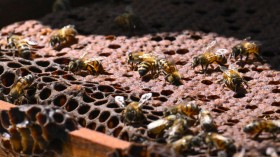A study by Royal Holloway University of London reports that exposure to a commonly used pesticide causes stunted growth in bumblebees.
When exposed to the pesticide pyrethroid, which is used on flowering crops to prevent insect damage, the bumblebees, which are pollinators of flowering plants, grow less and go on to produce young that hatch in smaller sizes, the researchers said.
The investigation was done over a four-month period, where researchers recorded the size of the bees, weighing them on micro-scales and monitoring the size of queens and and male drones produced by the colony.
"We already know that larger bumblebees are more effective at foraging," said researcher Gemma Baron. "Our result, revealing that this pesticide causes bees to hatch out at a smaller size, is of concern as the size of workers produced in the field is likely to be a key component of colony success, with smaller bees being less efficient at collecting nectar and pollen from flowers."
Baron and her colleagues report that the research was the first to be carried out on pyrethroid pesticides across the entire lifecycle of bumblebees.
"Bumblebees are essential to our food chain so it's critical we understand how wild bees might be impacted by the chemicals we are putting into the environment. We know we have to protect plants from insect damage but we need to find a balance and ensure we are not harming our bees in the process," said Mark Brown, a professor at Royal Holloway who was involved in the study.
The researchers contend that in light of their results there will likely be further bans on pyrethroid pesticides throughout the European Union, where there is already a moratorium on the use of three neonicotinoid pesticides, which have been linked to colony collapse disorder.
"Our work provides a significant step forward in understanding the detrimental impact of pesticides other than neonicotinoids on wild bees," Nigel Raine, an expert on bee health.
"Further studies using colonies placed in the field are essential to understand the full impacts, and conducting such studies needs to be a priority for scientists and governments," he said.
The research is published in the Journal of Applied Ecology.
© 2024 NatureWorldNews.com All rights reserved. Do not reproduce without permission.





